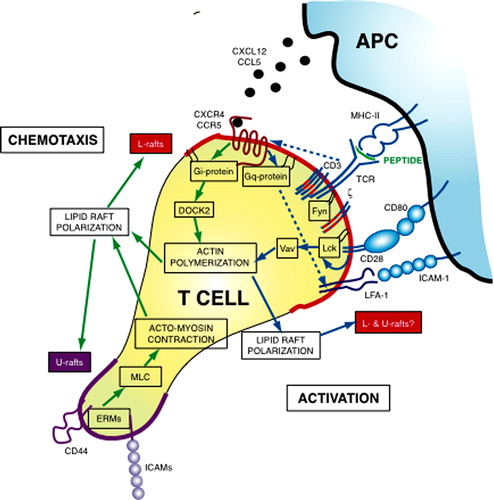Figures & data
Figure 1. A molecular model for lipid rafts in T cell polarization. The scheme shows the main signaling events leading to T cell polarization during chemotaxis (green arrows) and activation (blue arrows). Chemotactic signaling is initiated when chemokines activate chemokine receptors in lipid rafts. In the absence of other signaling pathways, activated chemokine receptors couple to Gi proteins initiating actin rearrangements through a DOCK2/Rac-dependent pathway. Actin rearrangements probably lead to lipid rafts polarization, which culminate in segregation of two lipid raft types: L-rafts (red lines) at the leading edge and U-rafts (violet line) at the uropod. L-rafts polarization enhanced directional sensing by increasing chemokine receptors and integrins (such as Lymphocyte Function-Associated Antigen-1, LFA-1) at the leading edge; at this cell site, L-rafts may also favor protrusive activity by concentrating cholesterol-rich domains that help actin-induced membrane deformation. U-rafts concentrate adhesion receptors at the rear, triggering localized activation of ERM proteins. Activated ERM then stimulate cell contraction by regulating Myosin Light Chain (MLC) phosphorylation, likely through a RhoA/ROCK pathway. Actomyosin contraction reinforces lipid raft polarization, enabling the persistence in polarization. When the T lymphocyte reaches the proper APC, TCR/CD28 signaling induces cell polarization toward the antigenic stimulus and organizes the mature immune synapse. Lipid rafts are recruited at the T cell/APC contact region, even if it is not known whether L- and U-rafts segregate to opposite cell poles during IS formation or if both L- and U-rafts concentrate at the IS. TCR activation also leads to a major change in chemokine receptor signaling that, in this condition, couple preferentially to Gq/11 instead of Gi. Signaling through Gq/11 induce T cell adhesion rather than migration either by enhancing LFA-1 affinity or by impeding Gi-mediated chemotactic signaling. Lipid rafts recruitment into the IS requires CD28 signaling through its cytoplasmic proline motif and Vav-1 activity, suggesting that raft dynamics are controlled by actin remodeling. By reorganizing lipid rafts, CD28 recruits signaling molecules, such as Lck, into the IS, and generates an environment where signal transduction is protected and amplified. Moreover, by controlling stiffness of the plasma membrane, lipid rafts enrichment at the IS may regulate fitting between T cell and APC.This Figure is reproduced in colour in Molecular Membrane Biology online.
